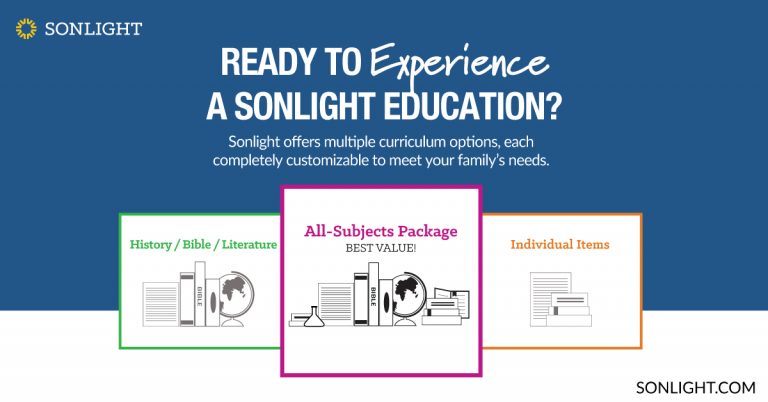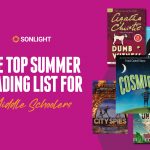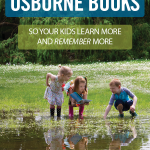
For several decades, Usborne has been publishing staples of home learning. Every time we open one of these favorites, we encounter a new vein of knowledge to be mined and new connections to be made. Four we especially love are
- The Usborne Book of World History used in HBLs B & C
- The Usborne World of Animals used in Science B
- The Usborne Book of Knowledge used in Science C
- The Usborne Time Traveler used in HBLs B & C
Though fiction arguably benefits from sparing illustrations, the visuals in an Usborne non-fiction have as much to offer as the text. Usborne illustrations trust the reader to see the significance of the content, rather than distracting with illustrative flourishes.
Because we come back so often to encounter this content, there are certain things we do to find more in the page and to set more of what we do find into long term memory.
1. Read with a Timeline and a World Map
Previously, I have suffered from what can only be described as, achronologia: the abject inability to place world events on a timeline. The Protestant reformation, the voyage of Columbus and the French Revolution could all have happened in the same week as far as I was concerned.
The problem is that events, more often than not, are only memorable in context. So, thanks to achronologia, history was lost in the mists of time, which in my case were especially misty.
A turning point came when I started to think up ways to rescue my children from the same fate. One morning, I read four information-laden pages of The Usborne Book of World History to three captivated pairs of eyes.
I shut the book and prompted them to a Charlotte Mason-style narration. Though hearing back from them that Cleopatra is the president of Africa does of course betray an absorption of sorts, I decided there was more I could do.
The next day, I drew a horizontal line across six pages and laid them on the floor in front of the couch. I divided each into two, marking each section as a millennium from 4,000 BC to 2,000 AD.
I also laid a printed world map below it. Every time we encountered a major event in world history, we set a bottle-cap on the map and on the timeline. I was delighted to see the antidote to achronolgia was setting in: connections. “So this might be the same Pharaoh that Moses was talking to,” my seven-year-old said, as she moved the bottle-cap.
The Timeline Book is an essential companion to this method. Children can annotate and color as they stick the Timeline Figures in the right spots. Keep these and your bottlecap pages close at hand, and you stand a better chance of saving history from the dank fog of achronologia.
2. Criticize and Question
I previously described Usbone books as being information-laden, and that is true, but I’d like to urge you not to take it for granted.
I have noticed that when I let the propositions in a book wash over me, rather than challenging them, there is a flatness to my cognitive processes that leads to forgetfulness.
Although it can be draining to have your sentences broken up with interruptions, the right questions can change everything. “How do we know if the ancient Egyptians actually believed in their gods?” Maybe they did, but the challenge is worth the interruption.
Suppose, after inquiry, we find that every sentence was indeed correct. Is the book therefore truthful? Let us ask if it is excluding something central. If a book on the circulatory system failed to mention the heart, an educator would be amiss if she didn’t criticize the omission even if everything stated was accurate. What if a history book fails to mention the Sovereign Lord?
Our kids read correct statements based on the truth behind, between, and beneath those statements. So let’s read between the lines and criticize what we find there. It may make the difference between a flat thinker and life-long truth-teller.
3. Repeat Key Phrases
Repetition has of course been the long-time ally of the educator. The final stage of education, moreover, is to be able to repeat your findings in a form that blesses others. It should be unsurprising, then, that the simple repetition of a word or phrase is a suitable first step to deeper knowledge.
“In an area called the Delta,” says The Usborne Time Traveler on page 101, “the river splits into many channels.” My children’s eyes, understandably, were elsewhere as I read it, so I asked them to repeat a few words: "the Delta; the river splits.”
Rather than resisting the task, my five-year-old spontaneously points out the Delta on the map as he says the words. He was glad to see something that would have otherwise passed him by.
In the past, I have embarrassed them by quizzing, “Where does the Nile split?" But I’ve learned that I’m more likely to sharpen the focus if I start by asking them to repeat the phrases that seem important.
With three more tools in your toolbelt, I hope you’ll feel a little less worried that the information you painstakingly curate is not just washing over entertained faces.
Be confident in your purchase. SmoothCourse™ will guide you in three steps.








